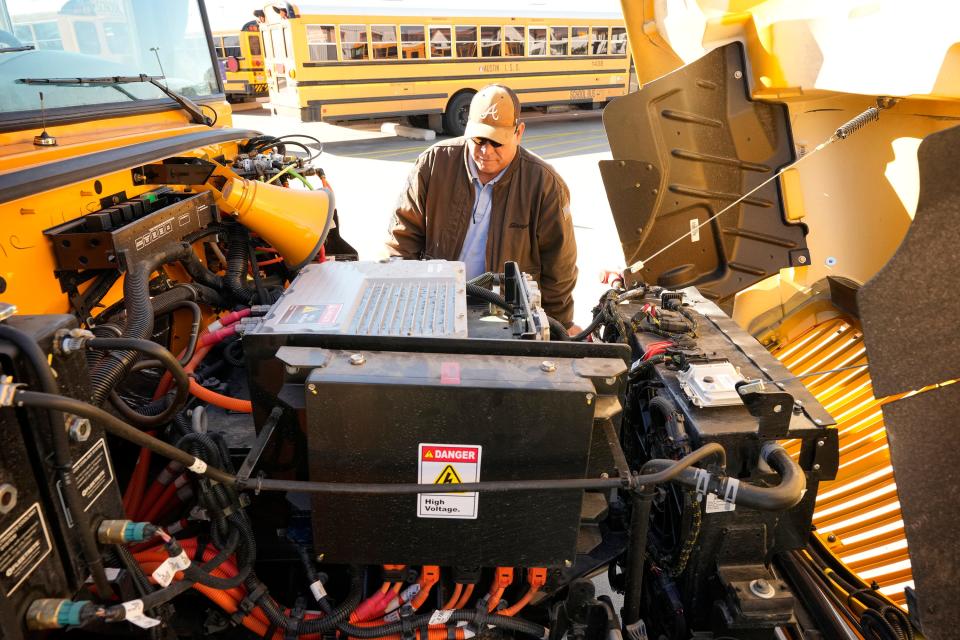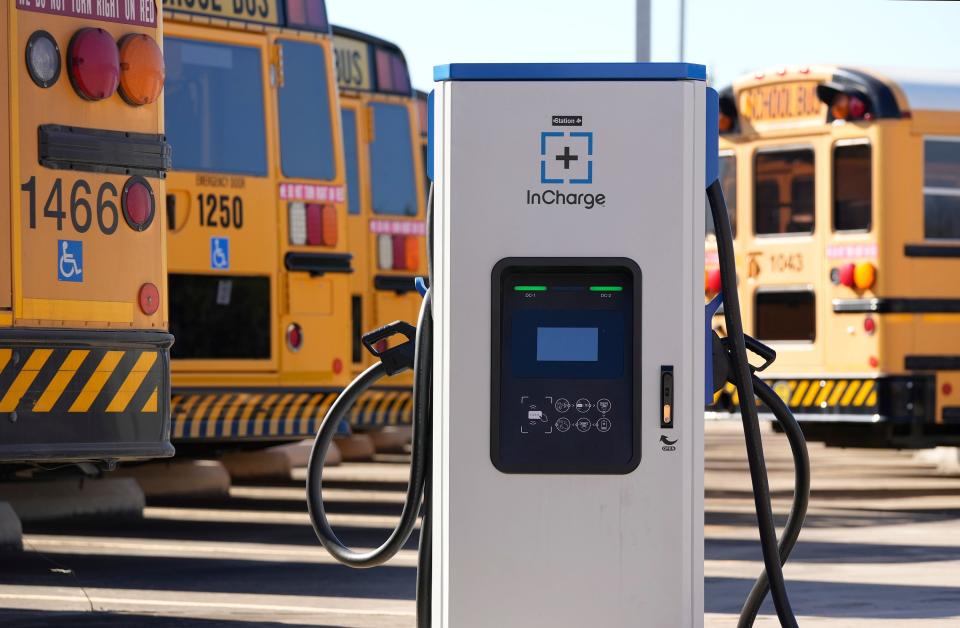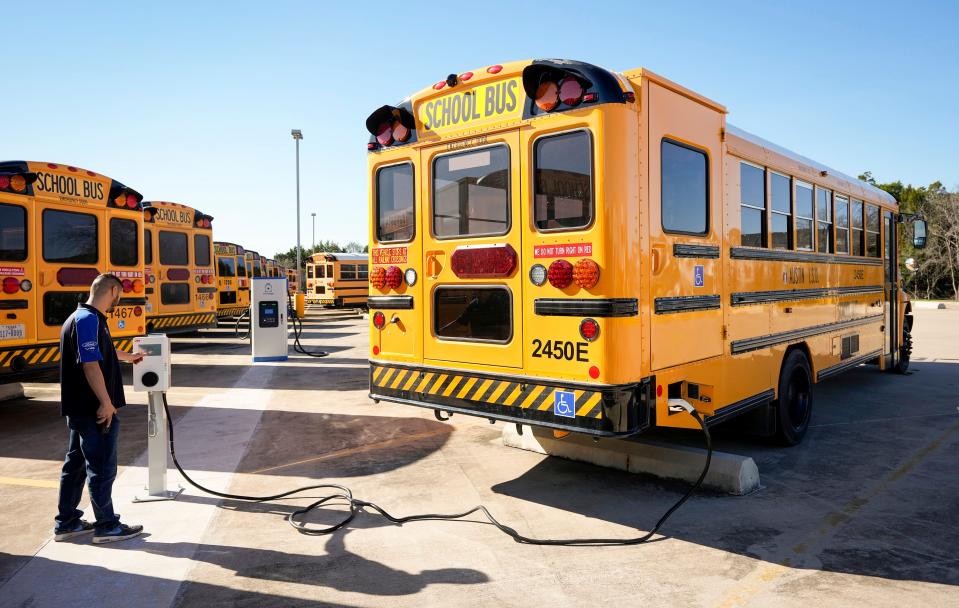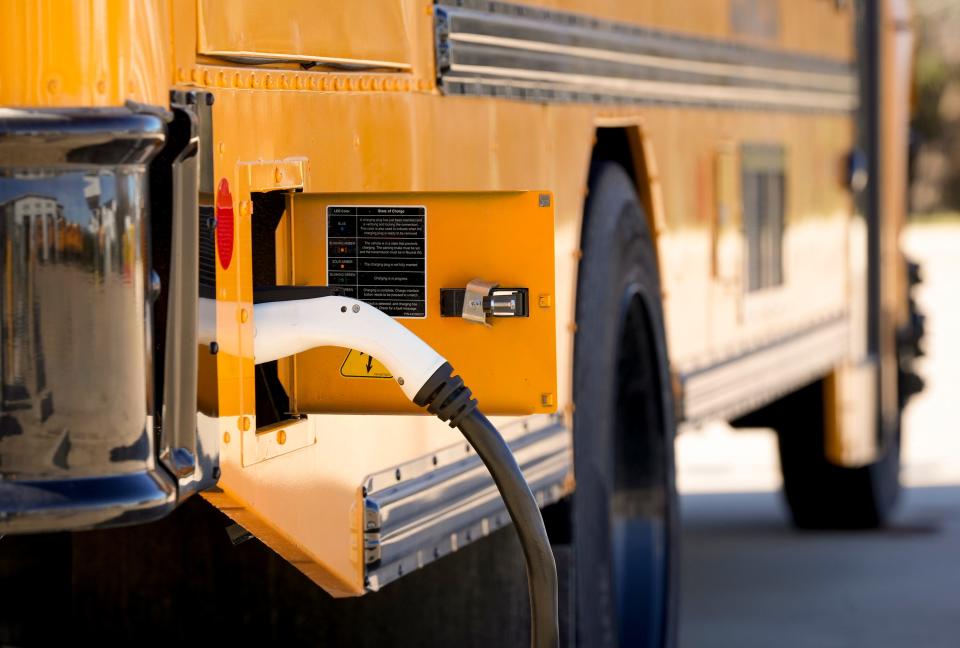Charging forward: AISD launches electric school buses as it moves from diesel to battery
On a bright, sunny Monday, a fleet of bright yellow school buses glints in the Austin school district's Southeast Bus Terminal at 7200 Bluff Springs Road.
Kris Hafezizadeh, the schools' executive director of transportation and vehicle services, walked aboard one of the district's newest buses as it clicked to life, with almost no detectable sound. In about 10 years, Hafezizadeh hopes Austin residents will no longer have to hear the familiar school bus rumble, nor see the black smoke or smell the diesel fumes that are ever-present with traditional buses.
The district's three newest buses, which began rolling on Austin streets this week, are electric, and their purchase marks Austin's first steps toward its commitment to have a fully electric school bus fleet by 2035. Officials hope the shift will be better for students' and residents' health and will produce environmental benefits.
The buses — two that are 40 feet and a smaller, accessibility bus — are the first electric ones for the Austin district, Hafezizadeh said.
"It's zero emissions, which is good for our employees, our students and the environment," Hafezizadeh said.

Though the electric vehicles look just like the traditional yellow buses that ferry students to school, they don't have fossil fuel engines and don't make the chugging sound of a typical diesel bus.
Because the buses are so quiet, the district embedded a small horn in the front and back of the vehicles so people who can't see should be able to hear the vehicles coming.
Each bus takes about seven to 10 hours to charge on a certain type of charger, though they take just three or four hours to charge on a faster charger. The district has the capacity to charge six buses at once, and it plans to only buy the fast chargers going forward, Hafezizadeh said.
Electric buses, however, do have a higher upfront cost — about $385,000 instead of about $135,000 for a diesel bus, Hafezizadeh said. But they require less maintenance than typical diesel buses, and the district will likely save on upkeep, he said.
The majority of the increased costs come from the four giant batteries mounted at the bottom of the buses, which are only noticeable if someone puts a mirror under the vehicles or crawls on the ground.
The district paid for the buses from the $489.7 million 2013 bond.

Right now, the buses are running routes that average about 120 miles per day, Hafezizadeh said. These aren't buses that students will be taking to out-of-town football games, at least not yet, though Hafezizadeh hopes the infrastructure and technology will improve fast enough to allow those longer trips.
For now, the district will be running the electric buses to try to find any bugs.
"With any new technology, any new software, we know there's going to be issues, but that doesn't mean you stop progress," Hafezizadeh said.
The district has a long-term plan to shift to electric buses.
The $2.4 billion bond voters approved in 2022 will revamp the Nelson Bus Terminal in Northeast Austin, and the district plans to include electric charging stations as part of its renovation, Hafezizadeh said.

Replacing the district's entire 551-bus fleet with electric vehicles is a big lift, said Michael Mann, the district's executive director of construction management.
To plan for the electric bus rollout through 2035, the district hopes to commission a master plan that would detail the necessary purchase and construction needs, he said. That master plan could also outline needed upgrades to the bus terminals.
School districts in Texas and across the nation are embracing electric school buses.
The Del Valle district in January announced it planned to start purchasing the electric vehicles. In East Texas, the small Martinsville district replaced all four of its diesel buses with electric ones, the Texas Tribune reported.

About 28%, or 1.4 million, of Texas' children ride a school bus every day, according to the nonprofit Texas Electric School Bus Project.
It's possible the Austin district at some point could install solar panels to power its buses, Hafezizadeh said. Until then, the district is working with Austin Energy.
The district expects to get an additional 25 electric school buses after it was awarded a $6.3 million federal grant last month. The district will need to match about $7 million to fully pay for the vehicles.
The U.S. Environmental Protection Agency on Jan. 8 announced almost $1 billion in awards to 280 school districts across the country, including Austin, San Marcos and Del Valle, to buy electric school buses as part of a nationwide effort to create cleaner environments around schools.
The total $965 million federal grant will help school districts in 37 states purchase more than 2,700 buses. In Texas, 19 school districts will receive funding to buy more than 100 electric buses. The initiative is part of the EPA’s $5 billion Clean School Bus Program, which is funded through the bipartisan 2021 Infrastructure Investment and Jobs Act.
This article originally appeared on Austin American-Statesman: Austin ISD launches electric buses as it moves from diesel to battery

